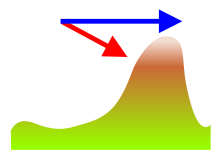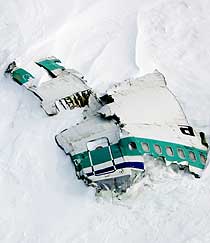
Avionics are the electronic systems used on aircraft. Avionic systems include communications, navigation, the display and management of multiple systems, and the hundreds of systems that are fitted to aircraft to perform individual functions. These can be as simple as a searchlight for a police helicopter or as complicated as the tactical system for an airborne early warning platform.

American Airlines Flight 965 was a regularly scheduled flight from Miami International Airport in Miami, Florida, to Alfonso Bonilla Aragón International Airport in Cali, Colombia. On December 20, 1995, the Boeing 757-200 flying this route crashed into a mountain in Buga, Colombia, around 9:40 pm killing 151 of the 155 passengers and all eight crew members.
In aviation, a controlled flight into terrain is an accident in which an airworthy aircraft, fully under pilot control, is unintentionally flown into the ground, a mountain, a body of water or an obstacle. In a typical CFIT scenario, the crew is unaware of the impending disaster until it is too late. The term was coined by engineers at Boeing in the late 1970s.

A ground proximity warning system (GPWS) is a system designed to alert pilots if their aircraft is in immediate danger of flying into the ground or an obstacle. The United States Federal Aviation Administration (FAA) defines GPWS as a type of terrain awareness and warning system (TAWS). More advanced systems, introduced in 1996, are known as enhanced ground proximity warning systems (EGPWS), a modern type of TAWS.

Aviation safety is the study and practice of managing risks in aviation. This includes preventing aviation accidents and incidents through research, educating air travel personnel, passengers and the general public, as well as the design of aircraft and aviation infrastructure. The aviation industry is subject to significant regulation and oversight.

A traffic collision avoidance system, also known as a traffic alert and collision avoidance system, is an aircraft collision avoidance system designed to reduce the incidence of mid-air collision (MAC) between aircraft. It monitors the airspace around an aircraft for other aircraft equipped with a corresponding active transponder, independent of air traffic control, and warns pilots of the presence of other transponder-equipped aircraft which may present a threat of MAC. It is a type of airborne collision avoidance system mandated by the International Civil Aviation Organization to be fitted to all aircraft with a maximum take-off mass (MTOM) of over 5,700 kg (12,600 lb) or authorized to carry more than 19 passengers. CFR 14, Ch I, part 135 requires that TCAS I be installed for aircraft with 10-30 passengers and TCAS II for aircraft with more than 30 passengers. ACAS/TCAS is based on secondary surveillance radar (SSR) transponder signals, but operates independently of ground-based equipment to provide advice to the pilot on potentially conflicting aircraft.

A flight recorder is an electronic recording device placed in an aircraft for the purpose of facilitating the investigation of aviation accidents and incidents. The device may often be referred to colloquially as a "black box", an outdated name which has become a misnomer—they are now required to be painted bright orange, to aid in their recovery after accidents.

An airborne collision avoidance system operates independently of ground-based equipment and air traffic control in warning pilots of the presence of other aircraft that may present a threat of collision. If the risk of collision is imminent, the system recommends a maneuver that will reduce the risk of collision. ACAS standards and recommended practices are mainly defined in annex 10, volume IV, of the Convention on International Civil Aviation. Much of the technology being applied to both military and general aviation today has been undergoing development by NASA and other partners since the 1980s.
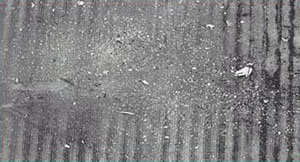
American Eagle Flight 4184, officially operating as Simmons Airlines Flight 4184, was a scheduled domestic passenger flight from Indianapolis, Indiana to Chicago, Illinois, United States. On October 31, 1994, the ATR 72 performing this route flew into severe icing conditions, lost control and crashed into a field. All 68 people aboard were killed in the high-speed impact.
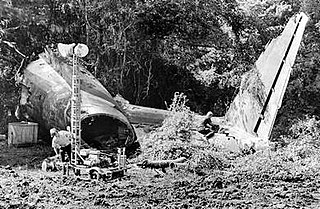
Eastern Air Lines Flight 212 was a controlled flight into terrain accident of a McDonnell Douglas DC-9 during approach to Charlotte Douglas International Airport in North Carolina. The incident occurred on September 11, 1974, killing 72 of the 82 people on board. The scheduled flight was from Charleston Municipal Airport to Chicago O'Hare, with an intermediate stop in Charlotte.

Southwest Airlines Flight 1455 was a scheduled passenger flight from McCarran International Airport, Las Vegas, Nevada, to Burbank-Glendale-Pasadena Airport, Burbank, California, that overran the runway during landing on March 5, 2000. The aircraft, a Boeing 737-3T5, registration N668SW, came to rest on a city street adjacent to a gas station. The National Transportation Safety Board found that the incident was due to the pilots attempting to land with excessive speed. They also found that the air traffic controller placed them in a position from which their only option was a go around. Two of the passengers were seriously injured, and there were many minor injuries. As a result of the incident, the airport installed an Engineered Materials Arrestor System (EMAS) at the east end of the incident runway. The aircraft was written off, making the incident the 10th hull loss of a Boeing 737-300. This was the first major accident in the airline's 29-year history.
The Capstone Program was a United States government-funded aviation safety program for the state of Alaska, primarily focusing on rural areas of the state. This joint effort – between the Federal Aviation Administration (FAA), the Alaska Pilot's Association, commercial operators, the University of Alaska, MITRE Corporation, some avionics manufacturers and individual pilots – cut the accident rate in the eastern part of Alaska by around 40%.
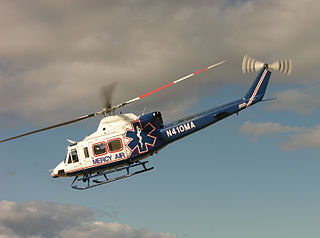
The safety of emergency medical services flights has become a topic of public interest in the United States, with the expansion of emergency medical services aviation operations, such as air ambulance and MEDEVAC, and the increasing frequency of related accidents.

Charles Donald Bateman, often known as Don Bateman, was a Canadian electrical engineer and the inventor of the Ground Proximity Warning System (GPWS), a device that is responsible for a marked decline in controlled flight into terrain accidents, such as the Mount Erebus Disaster with Air New Zealand Flight 901.
"It's accepted within the industry that Don Bateman has probably saved more lives than any single person in the history of aviation."

Flying Tiger Line Flight 66 was a scheduled international cargo flight from Singapore Changi Airport to Hong Kong's Kai Tak Airport via a stopover at Kuala Lumpur International Airport, Malaysia. On February 19, 1989, the FedEx-owned Boeing 747-249F-SCD crashed while on its final approach. The aircraft impacted a hillside 437 ft (133 m) above sea level and 12 km from Kuala Lumpur, resulting in all four crew members being killed.

PauknAir Flight 4101 was a British Aerospace 146 that crashed on a flight from Málaga, Spain, to the Spanish North African exclave of Melilla on 25 September 1998. All 38 passengers and crew on board the aircraft were killed in the accident.

Aviastar Flight 7503 was a regional flight from Masamba to Makassar, Indonesia. On 2 October 2015, the de Havilland Canada DHC-6 Twin Otter aircraft serving the route went missing with 10 on board near Palopo minutes after takeoff. There was no distress call from the plane.

Tara Air Flight 193 was a scheduled domestic passenger flight from Pokhara to Jomsom, Nepal. On 24 February 2016, eight minutes after take-off, the aircraft serving the flight, a Viking Air DHC-6-400 Twin Otter went missing with 23 people on board. Hours later, the wreckage was found near the village of Dana, Myagdi District. There were no survivors. It was Tara Air's deadliest accident.

The 2009 Aviastar British Aerospace 146 crash occurred on April 9, 2009, when a British Aerospace 146 crashed into Pikei Hill during a ferry flight from Sentani Airport to Wamena Airport, both in Indonesia's Papua province. Due to the force of the impact the aircraft was destroyed and all 6 crew members were killed. The aircraft was carrying voting paper to Wamena as well as several other goods, as a parliamentary election was held in the month. The wreckage was found in Pikei Hill, Tengah Mountain, Tangma, Yahukimo District.

Tara Air Flight 197 was a scheduled domestic flight operated by Tara Air for parent company Yeti Airlines from Pokhara Airport to Jomsom Airport in Nepal. On 29 May 2022, the Twin Otter aircraft carrying 22 people departed at 09:55 NPT and lost contact with air traffic controllers about 12 minutes later at 10:07 (04:22). The wreckage was located 20 hours later on a mountainside. All 22 passengers and crew were killed, and all 22 bodies were recovered. This was Tara Air's second deadly accident on this route, after Flight 193 in 2016.
